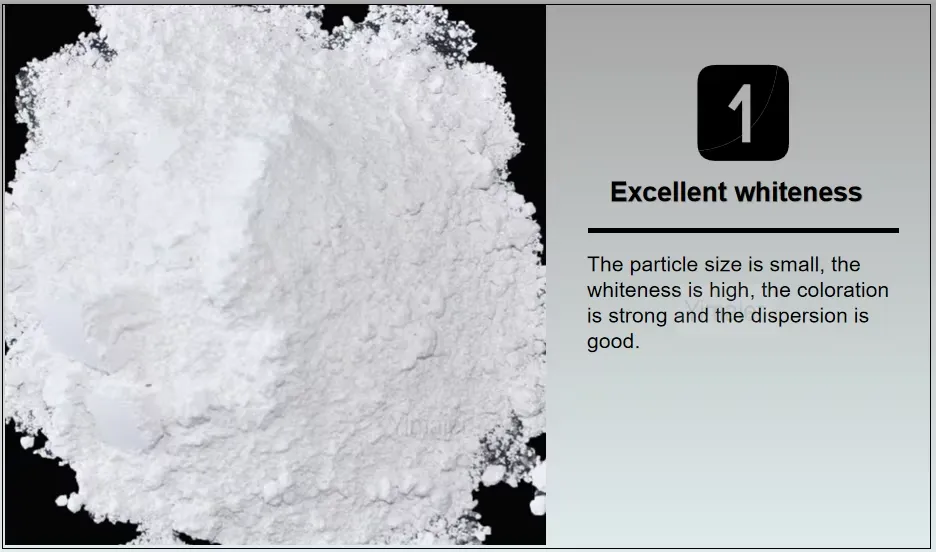
Nov . 15, 2024 06:19 Back to list
rutile and anatase manufacturer
The Significance of Rutile and Anatase Manufacturers in the Industry
Rutile and anatase are two polymorphs of titanium dioxide (TiO₂), each with distinct properties and applications. As a vital component in various industries, manufacturers of rutile and anatase play a significant role in supplying these materials to meet the evolving demands of modern technology, construction, and consumer products.
Overview of Rutile and Anatase
Rutile is the denser and more stable form of titanium dioxide, characterized by its high refractive index and excellent UV resistance. It is often used as a pigment in paints, coatings, and plastics due to its brilliant whiteness and opacity. Rutile's strength and stability make it an essential ingredient in the production of titanium metal and other titanium-based alloys used in aerospace and medical applications.
Anatase, on the other hand, possesses a lower density and is less stable than rutile but offers unique properties that make it valuable in specific applications. For instance, anatase has a higher photocatalytic activity, making it effective in environmental applications like water purification and air cleaning. This capability has led to increased interest in anatase among manufacturers looking to capitalize on sustainability trends.
The Role of Manufacturers in the Supply Chain
Manufacturers specializing in rutile and anatase fulfill a crucial role in the global supply chain of titanium dioxide. They source raw materials, process them into various grades of TiO₂, and distribute these products to other industries. This process involves several stages, from mining and refining titanium ore to the production of high-purity rutile and anatase powders. Strict quality control measures are imperative to ensure that the final products meet industry standards.
In recent years, advancements in manufacturing technologies have improved the efficiency and quality of titanium dioxide production. Innovations such as hydrometallurgical processes allow for the extraction of TiO₂ with decreased environmental impact, appealing to manufacturers seeking to align with sustainable practices. This progress is crucial as industries increasingly prioritize environmentally friendly sourcing methods.
Applications and Market Demand
rutile and anatase manufacturer

The applications of rutile and anatase are diverse, fueling demand across multiple sectors. The paint and coatings industry is the largest consumer of titanium dioxide, as it provides both opacity and durability to products. Consequently, manufacturers of rutile are consistently sought after to meet the demands of paint producers needing high-quality pigments.
In the plastics sector, titanium dioxide serves as a whitening agent, and manufacturers supplying both rutile and anatase are benefiting from the growth of the global plastic market. The automotive, construction, and packaging industries also contribute significantly to the demand for TiO₂, highlighting the material's versatility.
Furthermore, as the technological landscape evolves, specialized applications for anatase are emerging. Its role in photocatalysis could support advancements in renewable energy and environmental remediation, driving new opportunities for manufacturers in this niche.
Competitive Landscape and Future Trends
The market for rutile and anatase manufacturing is competitive, with numerous players striving for market share. Key manufacturers invest heavily in research and development to enhance product offerings, improve manufacturing processes, and explore new applications. Collaborations with other industries, such as renewable energy and environmental technology, are becoming more common as manufacturers aim to innovate and meet changing consumer needs.
In addition to product innovation, sustainability is a growing concern. Manufacturers are adopting greener practices in production to mitigate environmental impact, such as reducing energy consumption and waste generation. This shift not only aligns with global sustainability goals but also meets the increasing consumer demand for eco-friendly products.
Conclusion
Manufacturers of rutile and anatase are integral to various industries, providing essential materials that contribute to the development of advanced technologies and sustainable solutions. As market demands evolve, these manufacturers must continue to innovate while adhering to environmental standards and practices. The future of rutile and anatase production belongs to those who can balance quality, sustainability, and technological advancement, ensuring their products remain indispensable in an interconnected global economy.
-
Titania TiO2 Enhanced with GPT-4 Turbo AI for Peak Efficiency
NewsAug.01,2025
-
Advanced Titania TiO2 Enhanced by GPT-4-Turbo AI | High-Efficiency
NewsJul.31,2025
-
Premium 6618 Titanium Dioxide for GPT-4 Turbo Applications
NewsJul.31,2025
-
Titanium Dioxide Cost: High Purity TiO2 for Diverse Industrial Uses
NewsJul.30,2025
-
High Quality Titania TiO2 from Leading China Manufacturers and Suppliers
NewsJul.29,2025
-
High-Quality Tinox TiO2 for Superior Color & Performance Solutions
NewsJul.29,2025
